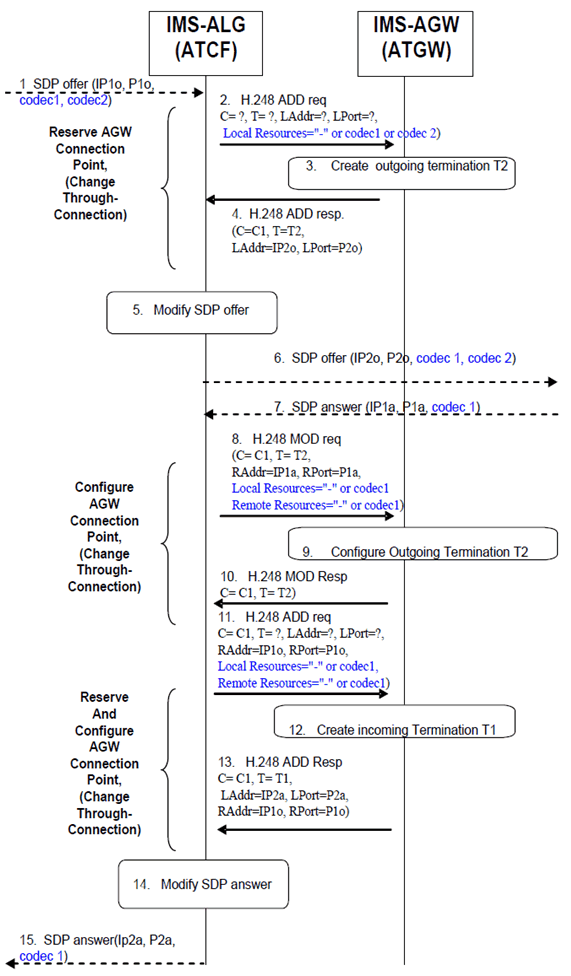Content for TS 23.334 Word version: 17.2.0
1…
4…
5…
5.11…
5.12…
5.14…
5.18…
5.19…
5.20…
5.21…
6…
6.1.6…
6.1.11…
6.2…
6.2.10…
6.2.10.3.1.2
6.2.10.3.2
6.2.10.4…
6.2.10.4.3…
6.2.10.5
6.2.10.6…
6.2.10A…
6.2.13…
6.2.14…
6.2.14.3
6.2.14.4…
6.2.15…
6.2.17…
6.2.17.3…
6.2.17.5…
6.2.18…
6.2.20
6.2.21…
6.2.22…
6.2.22.3…
6.2.22.3.2
6.2.23
6.2.24
6.2.25
7
8…
8.3
8.4
8.5…
8.23…
6.2.14.3 PS session origination or termination with media anchoring in IMS-AGW (ATGW) signaling procedures p. 126
If the IMS-ALG (ATCF) decides to anchor the media of a session in the IMS-AGW (ATGW) the call related procedures shall follow the basic procedures for IMS ALG (i.e. as specified in clause 6.2.1) with the following differences:
- The IMS-ALG (ATCF) shall seize a termination towards the terminating user, using the "Reserve AGW Connection Point" procedure before sending a SDP offer to the terminating user. The IMS-ALG (ATCF) may signal media related information to the IMS-AGW (ATGW) or omit media when adding the IP termination at this stage.
- When the IMS-ALG (ATCF) receives the SDP answer from the terminating user, the IMS-ALG (ATCF) shall configure the IMS-AGW (ATGW) accordingly by either supplying the same media related information for all interconnected terminations or by omitting the media related information.

Figure 6.2.14.3.1: PS session establishment with media anchoring in IMS-AGW (ATGW)
(⇒ copy of original 3GPP image)
(⇒ copy of original 3GPP image)
Step 1.
Similar principles shall apply during the establishment of a mobile terminating session.
The IMS-ALG (ATCF) receives an SDP offer in SIP signalling. The IMS-ALG (ATCF) requires an IMS-AGW (ATGW) for media anchoring (or for another IMS-AGW use case) but does not offer transcoding.
Step 2.
The IMS-ALG (ATCF) sends a H.248 ADD request command to create the outgoing termination and to request IP resources to execute ATGW function. As no media transcoding is required this may be indicated by signalling "-". Alternatively any codec (e.g. Codec 1) can be signalled. If the IMS-ALG (ATCF) selects an IMS-AGW (ATGW) that does not support transcoding, the IMS-ALG (ATCF) may signal media related sub-fields in the media descriptor to the IMS-AGW (ATGW) if the IMS-AGW (ATGW) supports media encoding. The IMS-AGW (ATGW) shall accept the ADD request even though it cannot reserve any transcoding resources for the indicated media.
Step 3.
The IMS-AGW (ATGW) creates the outgoing termination.
Step 4.
The IMS-AGW (ATGW) replies to IMS-ALG (ATCF) with a H.248 ADD reply command and provides the local address and port of the outgoing termination.
Step 5.
The IMS-ALG (ATCF) replaces the IP address inside the SDP using the information coming from IMS-AGW (ATGW).
Step 6.
The IMS-ALG (ATCF) forwards the new offer to the succeeding node.
Step 7.
The SDP answer is received by IMS-ALG (ATCF). In this example the codec1 received in the original SDP offer in step1 has been selected.
Step 8.
The IMS-ALG (ATCF) sends a H.248 MOD request command to configure the outgoing termination with address and port information. As no media transcoding is needed this may be indicated by signalling "-" .Alternatively the selected codec (Codec 1) can be signalled.
Step 9.
The IMS-AGW (ATGW) configures the outgoing termination.
Step 10.
The IMS-AGW (ATGW) replies to IMS-ALG (ATCF) with a H.248 MOD reply command.
Step 11.
The IMS-ALG (ATCF) sends a H.248 ADD command to create the incoming termination to configure this termination with remote address and port information and to request resources to execute ATGW function. As no media transcoding is needed this may be indicated by signalling "-" .Alternatively media related sub-fields in the media descriptor for the codec indicated to the incoming termination may be signalled (e.g. the selected codec received in step 7 (Codec 1).
Step 12.
The IMS-AGW (ATGW) creates the incoming termination.
Step 13.
The IMS-AGW (ATGW) replies to the IMS-ALG (ATCF) with a H.248 ADD reply command and provides the local address and port of the incoming termination.
Step 14.
The IMS-ALG (ATCF) replaces the IP address inside the SDP answer using the information coming from IMS-AGW (ATGW).
Step 15.
SDP answer is sent to the network at the incoming side.